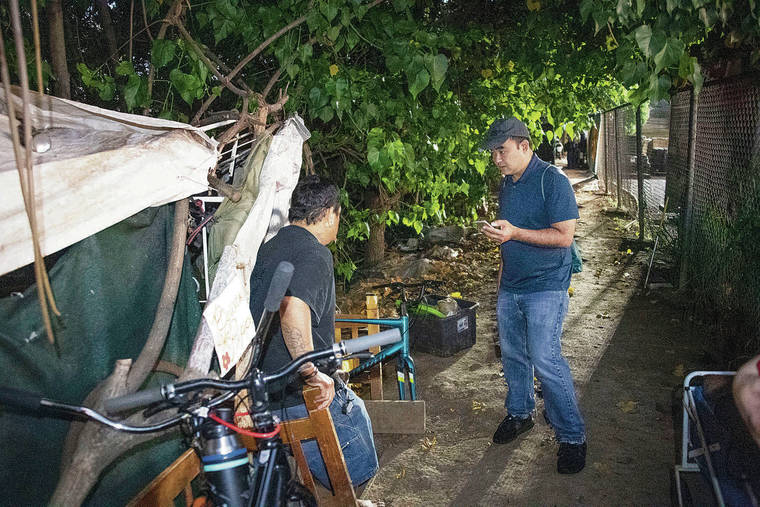‘Point in Time’ survey tallies Oahu’s homeless

CRAIG T. KOJIMA / CKOJIMA@STARADVERTISER.COM
The state’s homeless coordinator, Scott Morishige, right, talked to a man Thursday during a Point in Time Count. The man lives next to Waimalu Stream.
Outreach workers fanned out across Oahu on Thursday — starting at 4 a.m. — to survey the island’s homeless population in a one-day, compressed census as part of the nationwide Point in Time Count.
The neighbor islands this year will continue to spread their Point in Time Counts over multiple days — from Monday through Jan. 31 — although several major mainland cities only survey their homeless populations on a single night.
The reduction to a one-day count on Oahu was driven by a new app called Survey 123, which uploads the Point in Time Count data in real time.
At 5:57 a.m. Scott Morishige — the state’s homeless coordinator — took a break from surveying homeless people around Neal S. Blaisdell Park in Aiea and opened the app on his phone. At that point 69 homeless people had been surveyed across Oahu and another 67 were “observed,” meaning they were likely sleeping or did not want to participate in the survey.
>> Photo Gallery: Oahu’s homeless counted in annual survey Opens in a new tab
By 7:20 a.m. — with another four hours to go in the count — the numbers had jumped to 357 people surveyed and 297 others who had been observed.
Don't miss out on what's happening!
Stay in touch with breaking news, as it happens, conveniently in your email inbox. It's FREE!
They included Roby Batis, 68, and his girlfriend, Vicky Duff, 51, who live among the mangroves off of the Blaisdell Park jogging path that lines the shoreline.
They’ve been in the brush with their 13-year-old dog, Spike, for three years. Batis said the couple has been surveyed in the Point in Time Count before.
To break the ice, outreach workers gave them a bag of dog food for Spike and a “hygiene kit” of toothpaste, toothbrushes and other toiletry items, along with $5 gift cards for Longs and a coupon for a free meal at McDonald’s.
“Oh, McDonald’s! Free McDonald’s!” shouted Paulo Setu, 50, after answering the Point in Time Count questions, including how long he’s been on the street and some of the underlying causes of his homelessness.
Setu and about a dozen others live below a bridge on Kamehameha Highway on the mauka side of Blaisdell Park.
Emma Grochowsky, who works for Morishige, gently prodded people awake who were living in an overgrown encampment along a cyclone fence that divides a Cutter Mitsubishi dealership from the brush.
“Sorry to wake you so early,” Grochowsky said to one woman who slowly emerged from her tent at 6:45 a.m., just before the sun came up.
“It can take a while,” Grochowsky told the Honolulu Star-Advertiser. “Sometimes they want to talk, so you don’t just go through the questions. And a lot of times they answer a lot of questions before you even get to them. They talk about all kinds of things, like what happened before they became homeless.”
Bonnie Tokita, who described herself as a “a stay-at-home mom with two kids,” volunteered for this year’s Point in Time Count for the first time — but only wanted to be an observer with minimal interaction. But by listening as questions to the survey were being answered, Tokita, 49, said she got an education that belied some of her perceptions before she showed up at Blaisdell Park.
“It’s eye-opening,” she said. “I had prejudices and I was sort of afraid, but they’re just people. None of them were homeless as a choice. The most common reasons were not being able to pay the rent, or getting kicked out of where they were living.”
Many of the dozens of people surveyed around Blaisdell Park are considered “chronically homeless,” meaning they’ve been homeless for over a year, if not for several years.
They included Josie Betonio, 63, and her boyfriend, Nicholas Patrocinio, 53.
They live under a bridge along the jogging path where Betonio said the couple is rarely hassled by law enforcement.
“We’re out of sight,” she said. “As long as they don’t see you, we’re fine.”
In 2019 the Point in Time Count identified 6,448 homeless people across the islands. The 2019 numbers represented an 18.6% drop since 2016 — or a decrease of 1,473 people over the previous four years.
Oahu’s 2019 Point in Time Count, however, showed only a 1% drop in homelessness — meaning that Oahu’s homeless population fell to 4,453 people.
Overall, Hawaii’s 2019 numbers meant that the islands lost the ignoble distinction of having the nation’s worst per capita rate of homelessness — or 44.9 homeless per 10,000 people.
New York — with a rate of 46.4 homeless people per 10,000 people — now has America’s highest per capita rate of homelessness.
The results of this year’s Point in Time Counts for Hawaii are expected to be released in the next few months. At the end of the year, federal officials typically release each states results collectively, along with their per capita rankings.



